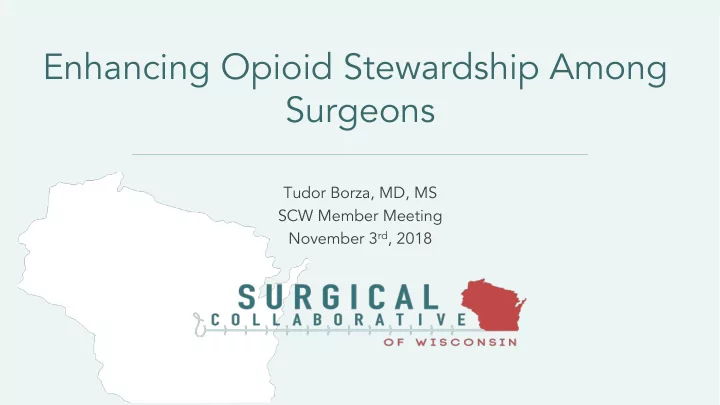

Enhancing Opioid Stewardship Among Surgeons Tudor Borza, MD, MS SCW Member Meeting November 3 rd , 2018
Overview Background of opioid epidemic Surgeon role Evidence for opioid reduction in surgery SCW opioid reduction strategy Targeting post-operative prescribing following laparoscopic • cholecystectomy Current prescribing patterns at the state level • Description of individual report •
Opioid Epidemic Nationally 17.4% of the population filled at least one prescription for an opioid in 2017 191,146,822 opioid prescriptions dispensed Ø 58.5 prescriptions per 100 persons CDC National Center for Injury Prevention and Control | 2018
Opioid Epidemic Nationally 42,249 persons in the United States died from drug overdoses involving opioids Ø 42% due to prescription opioids CDC National Center for Injury Prevention and Control | 2018
Opioid Epidemic in Wisconsin 883 opioid overdose deaths in 2017 Ø 63% due to prescription opioids Opioid Use Disorder Opioid Related Hospitalizations Wisconsin Department of Health Services, Office of Health Informatics and Opioid Harm Prevention Program
Surgeon Role 10% of all opioid prescriptions Ø Family practice 18%, Pain medicine 5% 2-5% of opioid naïve patients become addicted following surgery Paucity of national data or guidelines in surgical populations
Evidence for Opioid Reduction in Surgery Michigan Opioid Prescribing Engagement Network (OPEN) Illinois Surgical Quality Improvement Collaborative Opioids After Surgery Work Group
SCW Opioid Reduction Strategy Preoperative Perioperative Post Discharge • Education regarding • Alternative pre- and • Assessment of prior opioid tapering intraoperative pain opioid use management • Unused opioid disposal • Counseling regarding • Use of non-opioid risks of opioids • Monitoring for long term analgesia use • Counseling regarding • Minimizing discharge • Consideration of naloxone pain expectations opioid prescribing prescription
Starting with Laparoscopic Cholecystectomy Laparoscopic Perioperative Cholecystectomy GOAL GOAL: Reach a consensus among collaborative members regarding “ Best Practice ” prescribing of opioid analgesics following laparoscopic cholecystectomy and identify strategies to achieve this threshold.
Starting with Laparoscopic Cholecystectomy Common procedure performed by many SCW members Availability of expert recommendations from other collaboratives and working groups
Starting with Laparoscopic Cholecystectomy • Understand current prescribing patterns – State level prescribing patterns – Individual surgeon benchmarked reports • Agree upon SCW threshold • Provide education regarding alternative and adjunct pain management strategies • Allow for quantifiable assessment of improvement and serve as template for subsequent procedures
7-day Postoperative Prescribing • Opioid naïve patients Ø No fills in previous 6 months • Patients undergoing laparoscopic cholecystectomy • Individual surgeon and facility level data Ø Surgery form July 2016 through June 2017
7-day Postoperative Prescribing • 73% of patients filled an opioid prescription • Most commonly prescribed medications Ø Norco (hydrocodone/acetaminophen) - 57% Ø Percocet (oxycodone/acetaminophen) - 19% Ø Oxycodone -15%
Hospital-Level Variation
Surgeon-Level Variation
¡ ¡ Opioid ¡ ¡Prescribing ¡ Par2cipa2ng ¡ All ¡WI ¡ Recommenda2on* ¡ Hospitals ¡ ¡ Hospitals ¡ Number ¡of ¡Cases ¡ n/a ¡ ¡1,693 ¡ ¡3,986 ¡ Hydrocodone ¡(Norco) ¡5 ¡mg ¡ 15 ¡ 30 ¡(20-‑40) ¡ ¡ 30 ¡(20-‑30) ¡ Tablets ¡(Median, ¡IQR) ¡ Codeine ¡(Tylenol ¡#3) ¡30 ¡mg ¡ 15 ¡ 30 ¡(15-‑30) ¡ ¡ 25 ¡(20-‑30) ¡ Tablets ¡(Median, ¡IQR) ¡ Tramadol ¡50 ¡mg ¡Tablets ¡ 15 ¡ 30 ¡(20-‑40) ¡ ¡ 30 ¡(20-‑35) ¡ (Median, ¡IQR) ¡ Oxycodone ¡5 ¡mg ¡Tablets ¡ 10 ¡ 30 ¡(20-‑40) ¡ ¡ 30 ¡(20-‑40) ¡ (Median, ¡IQR) ¡ Hydromorphone ¡(Dilaudid) ¡ ¡ 10 ¡ 70 ¡(20-‑120) ¡ ¡ 25 ¡(18-‑60) ¡ 2 ¡mg ¡Tablets ¡(Median, ¡IQR) ¡
Develop a consensus Address barriers to threshold for the amount of decreasing postoperative opioids prescribed prescribing postoperatively Increase use of non-opioid Identify additional analgesics procedures to target
CDC National Center for Injury Prevention and Control | 2018
Opioid Percent Acetaminophen/Hydrocodone ¡Bita ¡ 1.0 Acetaminophen/codeine ¡Phosphat ¡ 2.2 Acetaminophen/hydrocodone ¡Bita ¡ 57.2 Acetaminophen/oxycodone ¡Hydroc ¡ 19.0 Acetaminophen/tramadol ¡Hydroch ¡ 0.1 Codeine ¡Sulfate ¡ 0.1 73% of patients undergoing lap Fentanyl ¡ 0.1 chole procedures had 1 or more Hydrocodone ¡Bitartrate/ibuprof ¡ 0.0 opioid fills within 7 days of Hydromorphone ¡Hydrochloride ¡ 0.5 Methadone ¡Hydrochloride ¡ 0.3 surgery Morphine ¡Sulfate ¡ 0.2 Oxycodone ¡Hydrochloride ¡ 14.9 Tapentadol ¡Hydrochloride ¡ 0.1 Tramadol ¡Hydrochloride ¡ 4.4
Variation in Median (IQR) Total MME Filled within 7 Days of Lap Chole Procedure Among SCW Hospitals
Recommend
More recommend